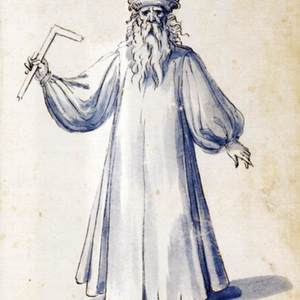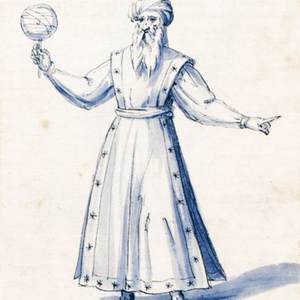Arcimboldo

Giuseppe Arcimboldo, "Self Portrait,"1575. Pen and blue pencil on paper, 23 x 15.7cm. Narodni Galerie, Prague

Giuseppe Arcimboldo, "Costume for the allegorical figure 'Geometry'"1585. Pen, blue wash on white paper, 301 x 203 mm. Galleria degli Uffizi, Florence

Giuseppe Arcimboldo, "Costume for the allegorical figure 'Astology'"1585. Pen, blue wash on white paper, 301 x 203 mm. Galleria degli Uffizi, Florence
Giuseppe Arcimboldo, "Maximilian II, His Wife, and Thre Children'" 1563. Oil on canvas, 240 x 188 cm. Kunsthistorisches Museum, Vienna
Born in Milan in 1526, not much is known about Arcimboldo's early life and training prior to his arrival at the Hapsburg court in Vienna in 1562. While there is some documentation of works designed for the Milan Cathedral between 1549 and 1558, little save for a few stained glass windows survive. What caused Arcimboldo to achieve the fame that led to his summons to Vienna in 1562 remains lost in history, though some have speculated that it may lie in early nature studies that laid the foundation for and hinted at the work he would later do with the Four Seasons and Four Elements (note 1). In his time at the Hapsburg court, first of Emperor Maximilian II and later at that of his son Rudolf II, Arcimboldo's role extended beyond that of simply a court painter. He was also responsible for designing a variety of other items for the court, such as costumes for pageants. And in addition to his composite portraits, Arcimboldo was responsible for creating more typical pieces for the royal family, such as the family portrait "Maximilian II, His Wife, and Three Children" (note 2).
His ties to the Austrian Hapsburg dynasty did not end upon Maximilian II's death in 1576, as Arcimboldo contiuned to work under the patronage of Maximilian's son, Rudolf II, until his death. Under Rudolf II, Arcimboldo continued his composite portrait tradition, most notably in his depiction of the emperor as the Etruscan god Vertumnus in 1590 (note 3).
Arcimboldo died in Milan in 1593 from kidney failure after begging a leave of absence from court earlier that decade.
Notes
note 1.In addition to the windows, there are records that he executed frescoes, banners, and coats of arms among other things. For more information, see Arcimboldo, 1527-1593, Nature and Fantasty. Washington D.C.: National Gallery of Art, 2010. Print. and Leydi, Silvio. "Giuseppe Arcimboldo in Milan: Documents and Hypotheses." Arcimboldo 1526-1593. Milan: Skia Editore, 2007. 37-71. Print.
note 2. Based on the ages of the children in the portrait (the youngest in the cradle, Ernst, was born in 1553), it is likely that this painting is actually a copy of an earlier one, albeit a copy still completed by Arcimboldo while at court.
note 3. For more on Rudolf II's reign and his relationship with Arcimboldo, see Evans, R.J.W. "The Imperial Court in the Time of Arcimboldo." The Arcimboldo Effect. New York: Abbeville, 1987. 35-53. Print.